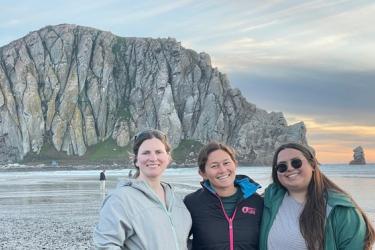The sounds you hear around you make up the soundscape, an acoustic background that persists throughout your everyday life. Soundscapes also exist in the ocean. As human noise contributions, such as shipping traffic, continue to increase, these sounds can shift from ambient noises to obstacles blocking communication between marine organisms. Thus, marine resource managers and policy makers are now trying to incorporate an understanding of human impacts on marine soundscapes when planning new projects and conserving marine ecosystems. However, due to the novelty of the field of soundscape ecology, there are few existing tools designed to study marine soundscapes.
This past year, my team of nine Fung Fellows at UC Berkeley worked with NOAA to address this issue. We created CalSound, a map-based website that visualizes and contextualizes sound data. Before we could tackle the issue, we interviewed marine resource managers and policy makers to better understand their work and how we might construct a tool to meet their needs. From our 12 interviews, we had three main takeaways:
- Policy is currently geared towards specific species, so centralizing data can provide users with a comprehensive and holistic look into marine ecosystems
- Multiple spatial and temporal scales must be considered to make educated decisions
- It is vital that animals and anthropogenic sources be considered together, but also independently to best understand their interactions.
Once we better understood which soundscape tools were needed, we used what we learned to design the CalSound website. Our tool works by displaying the paths traveled by drifting buoys carrying hydrophones (underwater microphones), marine mammals detected from the buoys, habitat models, shipping traffic, and oil drilling sites. These all provide insight into the composition of the soundscape near the buoys. Users can also click along the path of the buoy to observe graphs displaying various noise metrics. These features collectively illustrate the dynamics of marine ecosystems along the coast of California.
Since publishing CalSound, we continue to speak with those in the field to further improve and increase accessibility of our tool. We plan to present CalSound as a tool for conservation efforts at upcoming scientific conferences. Come check us out at the American Geological Union session “Imagining Ocean Science: Public Engagement Using Visualization and the Arts” in mid-December. We’ll also be at the Biennial Conference on the Biology of Marine Mammals in August 2022. We are excited to increase awareness of oceanic soundscapes and provide a tool that can assist in the conservation of marine organisms.
More Information

